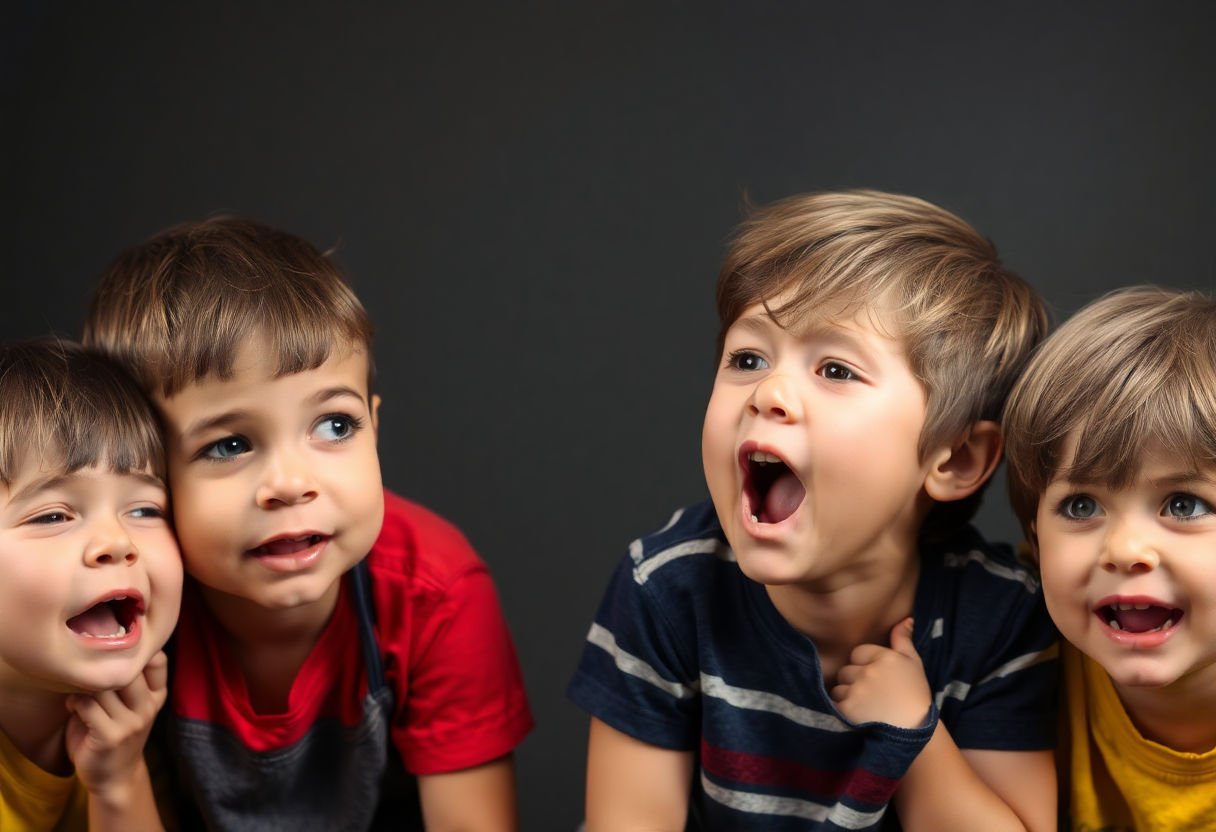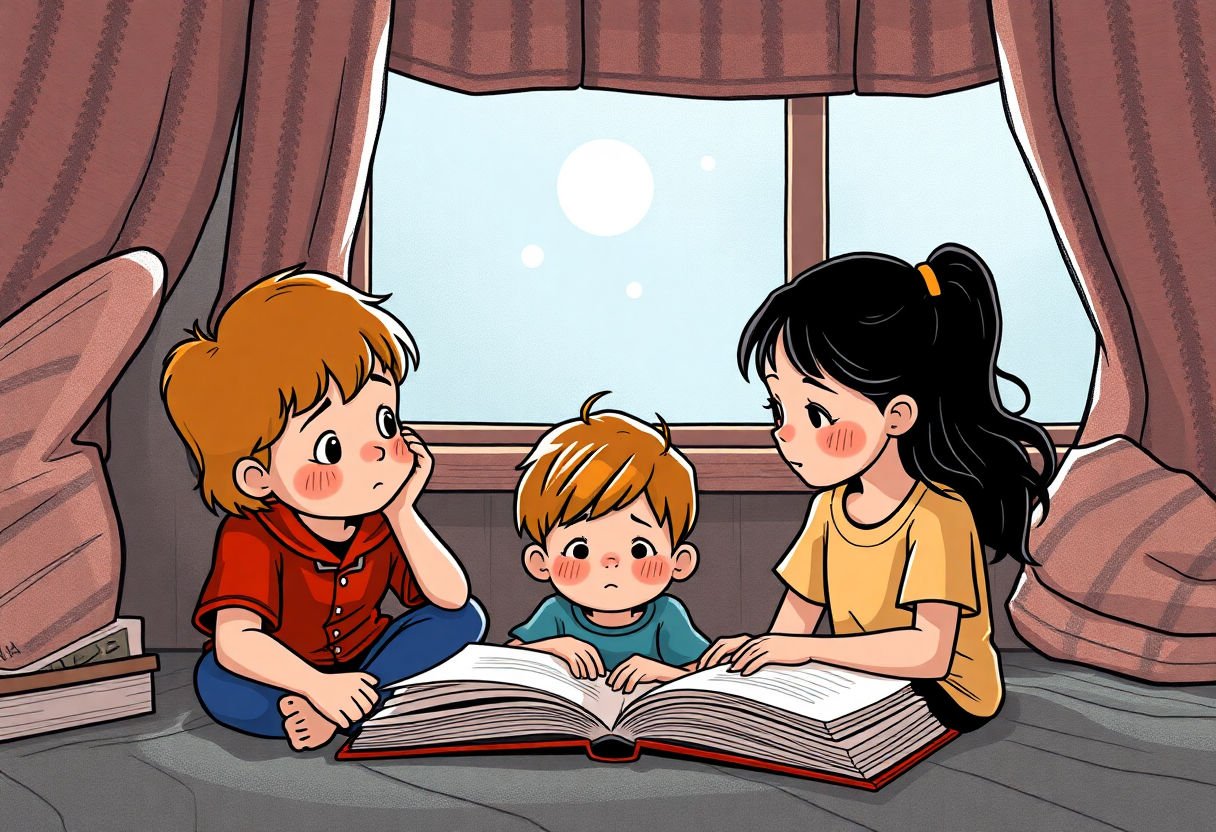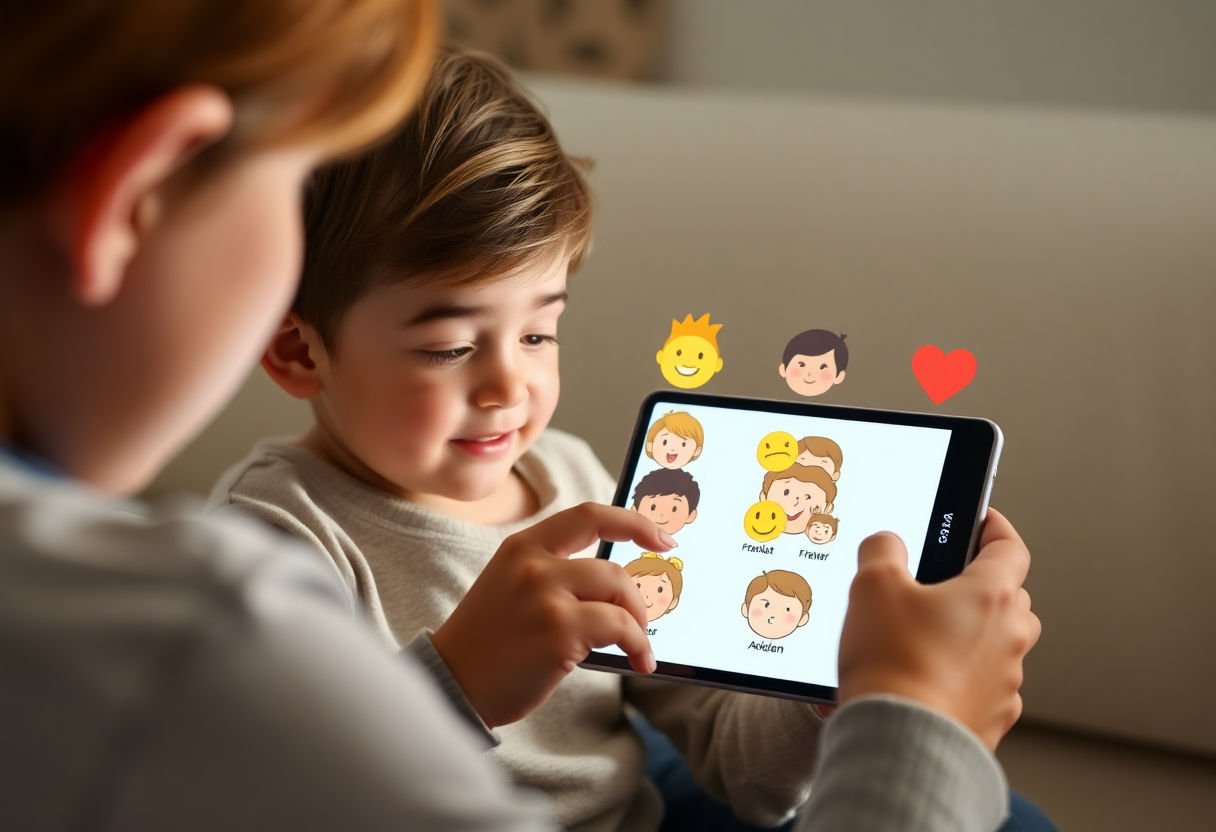Emotion faces are a creative and effective way to help children recognize and articulate their feelings. Understanding and identifying emotions such as happiness, sadness, anger, and surprise through facial expressions are integral to a child’s social development. This guide will explore various engaging methods, including role-playing and emotion cards, that aid emotional learning. By utilizing books, stories, and digital tools, kids can enjoy an interactive learning experience. By fostering these skills, children gain the ability to better manage their emotions and improve interactions with peers, an essential part of their growth journey.
Key Takeaways
- Emotion faces are a vital tool for helping children understand and articulate their feelings through engaging visual aids and activities.
- Recognizing facial expressions related to emotions like happiness and anger is fundamental for kids’ social and emotional development.
- Fun activities, such as games and role-playing, enhance a child’s ability to identify and express emotions effectively.
- Emotion cards serve as a practical resource for teaching and reinforcing the understanding of different emotions in children.
Understanding Emotions

Understanding emotions is a vital part of a child’s development. Emotions are complex responses that involve conscious experience, physiological arousal, and expressive behaviors. For children, recognizing these basic emotions is crucial for their growth and interaction with others.
Basic Emotions
At the core, there are several basic emotions that children can learn and understand:
- Happiness: Often displayed with a smile, laughter, or a joyful expression. It’s important for children to recognize happiness in themselves and others, as it fosters positivity and well-being.
- Sadness: Characterized by frowns, tears, or a downturned mouth. Understanding sadness helps children express when they are upset and can lead to seeking comfort or assistance.
- Anger: Shown through furrowed brows, glaring eyes, and a tense face. Recognizing anger is essential in helping children manage their reactions and interact peacefully with peers.
- Surprise: An open mouth and widened eyes often represent this emotion. Identifying surprise can enhance a child’s awareness and adaptability to new experiences.
Facial Expressions and Emotional Recognition
Facial expressions play a significant role in non-verbal communication. They are universal indicators of how someone feels, making it easier for children to understand without words. Teaching kids to interpret these expressions is fundamental for their emotional intelligence.
As children progress in understanding these expressions, they become better equipped to convey and process their emotions, leading to improved communication skills. Encouraging kids to mimic these expressions in playful scenarios can deepen their comprehension and ability to empathize with others, laying the groundwork for more nuanced emotional literacy.
Importance of Recognizing Emotions in Kids
Recognizing and understanding emotions play a pivotal role in a child’s personal and social development. When children identify emotions in themselves and others, they lay the groundwork for emotional intelligence, which is essential for navigating interpersonal relationships throughout life.
Emotional Awareness: Recognizing emotions allows children to develop an acute awareness of their own emotional states, leading to better self-regulation. When a child can label what they are feeling—be it happiness, sadness, or anger—they are better equipped to express their needs and seek support appropriately.
Social Interaction: Understanding emotional expressions enhances a child’s ability to interact socially. By interpreting the facial cues of peers, children can respond more empathetically and appropriately, building stronger, more positive relationships. This skill is crucial for cooperation, conflict resolution, and the formation of friendships.
Consider the impact of children who are enabled to recognize emotions:
- Improved Communication: When children articulate their emotions, misunderstandings decrease, leading to improved communication with adults and peers.
- Enhanced Empathy: Children who appreciate how others feel are often more empathetic, cultivating a sense of kindness and community.
- Reduced Behavioral Issues: Emotional recognition often correlates with a reduction in impulsive or inappropriate behavior, as children develop strategies to cope with their feelings.
Famed psychologist John Gottman notes, “Children who empathize with others are often more socially accepted,” highlighting the long-term benefits that emotional recognition can bring. By fostering these skills early, we equip children with the tools necessary for a fulfilling emotional and social existence.
Effective Activities to Learn Emotions
Learning emotions can be a delightful experience for children when approached through engaging and interactive activities. Integrating games and creative exercises into learning can significantly enhance a child’s ability to recognize and express emotions effectively. Here are some activities that can make this learning process both enjoyable and constructive:
-
Emotion Charades: This classic game can be adapted to teach emotions by having children act out different feelings using facial expressions and body language. It encourages them to actively think about how emotions are physically expressed and helps them become more adept at recognizing these expressions in others.
-
Storytime with Emotion: Reading stories and pausing to discuss how characters may be feeling fosters empathy and enhances emotional intelligence. Children can predict emotions, offering insights into their understanding while learning to connect narrative events with emotional responses.
-
Emotion Art Projects: Encourage children to express their feelings through art. Provide materials for drawing or crafting, and prompt them to create based on a particular emotion, asking them to visualize what happiness, anger, or sadness looks like. This helps them to personally connect with emotions and visualize them in unique, memorable ways.
-
Emotion Mirror Exercises: Stand in front of a mirror with the child and together make faces that exhibit different emotions. This activity not only helps in understanding facial expressions but also boosts self-awareness and emotional regulation by showing how their own faces change with different feelings.
Incorporating these activities into daily routines can make the process of learning emotions a joyful journey, fostering a deeper understanding and effective expression of emotions in children.
Using Emotion Cards
Emotion cards are a powerful tool in the emotional education of children, serving as both a visual aid and an interactive resource. These cards typically feature illustrations of diverse emotional expressions, making them an excellent method for kids to familiarize themselves with different feelings.
One of the key benefits of using emotion cards is their ability to help children recognize and label emotions accurately. Recognizing emotions is a fundamental skill that children must develop for effective social interactions. Emotion cards act as a visual representation of various emotional states, allowing children to associate a specific facial expression with a corresponding emotion.
Emotion cards can also serve as conversation starters, facilitating discussions between children and caregivers about feelings. For example, a child may draw an emotion card showing a sad face, which can lead to questions like, “What makes you feel sad?” or “How do you feel when you’re sad?” These discussions are crucial for helping children build emotional vocabulary and understand the nuances of different feelings.
Furthermore, emotion cards can be used in various engaging activities. Some effective ways to incorporate them include:
- Matching games, where children match the emotion card with a similar picture of someone expressing the same emotion.
- Storytelling exercises, where children create stories based on the emotion cards they draw, fostering both creativity and emotional insight.
- Role-playing scenarios, encouraging children to express the emotion depicted on a card through words and body language.
In summary, emotion cards are not only educational but also enjoyable, offering children a multidimensional approach to understanding emotions in a supportive and playful manner.
How Role-Playing Can Help

Role-playing is an innovative and impactful method to assist children in learning how to express and manage their emotions. By engaging in role-playing activities, children can explore different emotional scenarios in a safe environment. This helps them to not only recognize various emotions but also understand the appropriate ways to express and react to them.
Developing Emotional Intelligence: Through role-playing, children practice the skills necessary to identify emotions in themselves and others. Acting out different scenarios enables them to grasp the nuances of emotional expressions and reactions. For instance, pretending to be characters in a story allows them to experiment with feelings like anger, fear, and joy, fostering a deeper understanding of these emotions.
Building Empathy: Role-playing encourages children to adopt perspectives other than their own. By stepping into another’s shoes, they learn to appreciate different viewpoints, which is crucial for building empathy. This empathy can enhance their social interactions and improve their relationships with peers.
Enhancing Problem-Solving Skills: Scenarios in role-playing often require children to navigate complex emotional situations. This aspect of play trains them in problem-solving, as they ponder over how characters should react or resolve conflicts. Consequently, they gain confidence in handling real-life emotional challenges effectively.
Boosting Communication Abilities: Expressing emotions through dialogue in role-playing improves children’s verbal and non-verbal communication skills. They learn how tone, facial expressions, and body language can influence the message conveyed in expressions, thus contributing to their overall communicative competence.
Incorporating role-playing in emotional education is not only engaging but brings a multidimensional benefit to children’s development. It proves to be an essential tool in their journey to becoming emotionally aware and expressive individuals.
Books and Stories for Emotional Learning

Books and stories are powerful tools for emotional learning. They provide children with opportunities to explore feelings in a safe and imaginative environment. By engaging with narratives, children can identify with characters, understand diverse perspectives, and learn appropriate emotional responses.
One highly recommended book is “The Color Monster: A Pop-Up Book of Feelings” by Anna Llenas. This interactive book uses vibrant visuals to teach young readers about emotions through a lovable character. The story guides children to recognize and articulate their feelings by associating each emotion with a color, making the learning process enjoyable and memorable.
Another valuable resource is “Today I Feel Silly: And Other Moods That Make My Day” by Jamie Lee Curtis. Through rhythmic storytelling and playful illustrations, this book encourages children to reflect on their emotions and understand that their moods can change throughout the day.
“The Way I Feel” by Janan Cain is also an essential addition to any child’s bookshelf. This book delves into various emotions with simple explanations and captivating visuals, ensuring that young readers can easily grasp complex emotional concepts.
For older children, “Inside Out: Emotional Adventures”, inspired by the popular animated film, provides an engaging narrative that helps kids understand the intricacies of emotions like joy, fear, and anger. It encourages empathy and self-awareness as children journey with the characters.
By incorporating these books into a child’s reading regimen, parents and caregivers can facilitate important conversations around emotions, paving the way for greater emotional intelligence and resilience.
Digital Tools and Apps

In today’s digitally driven world, children’s emotional learning can be significantly enhanced through innovative apps and digital tools. These resources offer an interactive and engaging platform that captures children’s attention and provides them with a valuable learning experience. Here are some popular digital tools and apps that are transforming how kids perceive and understand emotions:
-
Mood Meter: This app allows children to label and track their emotions daily. It assists them in identifying feelings, improving self-awareness, and learning how their emotions change over time. The visual interface of the Mood Meter makes it simple for kids to navigate and fun to use.
-
Emotional ABCs: Designed as a comprehensive program, Emotional ABCs helps kids explore and understand emotions through a series of interactive lessons and games. This app offers exercises that foster emotional intelligence and problem-solving skills, making it a popular choice among educators and parents.
-
Daniel Tiger’s Grr-ific Feelings: Leveraging the popularity of the PBS character Daniel Tiger, this app teaches children about different emotions through songs, games, and videos. The engaging content is designed to help kids express their feelings constructively.
-
Breathe, Think, Do with Sesame: This app equips young children with skills to handle everyday challenges and frustrations. Through fun and interactive activities, kids learn the importance of breathing techniques and problem-solving strategies to manage their emotions effectively.
These digital tools and apps play a crucial role in supporting the emotional development of children. By integrating technology into emotional education, parents and educators can offer a versatile approach that is both interactive and effective, paving the way for more emotionally intelligent future generations.
The Role of Parents and Caregivers

Parents and caregivers play a crucial role in helping children navigate their emotional world. By providing support and guidance, they enable kids to better recognize and express their emotions constructively. Here’s how they can actively contribute:
-
Modeling Emotional Expression: Children often learn by observing those around them. Parents and caregivers should strive to be role models by expressing emotions openly and appropriately. This includes discussing feelings in daily life, which can demystify complex emotions and make children more comfortable with their own.
-
Creating a Safe Environment: It’s essential to establish a secure and nurturing environment where children feel safe to express their emotions without judgment. This involves active listening and validating their feelings, ensuring kids know that their emotions are acknowledged and respected.
-
Engaging in Emotional Conversations: Encourage conversations about emotions by asking open-ended questions. For example, after watching a movie, discuss how characters might feel and why, fostering empathy and analytical thinking about emotions.
-
Using Visual Tools: Introduce visual aids like emotion cards and facial expression charts to make learning about emotions engaging and tangible. These tools can be incorporated into everyday activities, making emotional education an integral part of the child’s routine.
-
Empowering Through Praise: Recognize and praise children when they correctly identify or appropriately express their emotions. Positive reinforcement can boost their confidence and willingness to understand their emotions further.
By actively participating in these ways, parents and caregivers establish an essential foundation for their child’s emotional development, equipping them with skills crucial for both present and future interpersonal interactions.
Conclusion
In conclusion, utilizing emotion faces as a teaching tool is invaluable in fostering emotional growth among children. By integrating these visual aids into daily activities, kids not only improve their ability to recognize and interpret emotions but also enhance their social skills and personal development. As we continue to explore and innovate in this area, maintaining an engaging environment for emotional learning will be crucial to long-term success. Encourage children to embrace their emotions with creativity and curiosity, and provide continued support to ensure their emotional understanding evolves alongside their growth.
Frequently Asked Questions
How can emotion faces help my child develop emotional intelligence?
Emotion faces serve as powerful visual tools that help children identify and articulate their feelings. By associating facial expressions with emotions, kids can enhance their emotional intelligence, which is crucial for their social and personal development.
At what age should I introduce emotion faces to my child?
Emotion faces can be introduced to children as young as two years old. At this age, kids begin to recognize facial expressions and can start learning to associate them with specific emotions, making it an ideal time to engage them with these tools.
What are some effective ways to use emotion cards with children?
Emotion cards can be integrated into daily activities, such as storytelling or role-playing, to reinforce emotional recognition. Encourage children to use the cards to express how they feel during different situations, which can aid in building their emotional vocabulary.
Are apps and digital tools beneficial for teaching emotions to children?
Yes, apps and digital tools provide interactive experiences that can make learning about emotions engaging and fun for children. These tools often include games and activities that encourage the exploration and expression of different emotional states.
How important is parental involvement in teaching kids about emotions?
Parental involvement is crucial as it models emotional recognition and expression for children. By actively participating in activities and discussions about emotions, parents can support their children’s emotional learning and understanding.


